
No one wants badly behaved tourists blocking views, partying wildly in the streets or pricing local people out of their own cities. So, how to be a better tourist? Here are some ways.
Some residents in Barcelona have taken action against overtourism by getting a bus route removed from Google Maps — the buses would often end up too packed with sightseers for people to get home from work. That is not to say the city is off-limits. But try to understand what is driving the protests and upset of local people. You can travel anywhere with a desire to reduce the negative impact of your trip and increase the positives.
Do research before you go — you’ll get more out of the destination and it will be appreciated. Remember you are taking a holiday in someone else’s home. Travelling with respect earns you respect. Learn a few phrases of the local language — it’s a gesture, but gestures do matter. A little bit of understanding goes a long way.
Slow tourism is about spending more time in a destination, engaging in the local culture and getting to know local people. Instead of a city-only break, try to spend time in the surrounding countryside, too. For example, if you visit Jingdezhen, you can visit the city’s traditional craftspeople, and then spend a couple of nights in the region.
Paris and Rome will always be on tourists’ bucket lists, but part of the joy of travel is researching lesser-known destinations. Robert Frost said: “Two roads diverged in a wood, and I took the one less traveled by, and that has made all the difference.” Richard Hammond, the founder of Green Traveller, says: “When I went to New Zealand, instead of hiking the 10 Great Walks, I researched 10 alternative walks. There was almost no one on them and the scenery was still pretty amazing.”
原创编写 版权所有 侵权必究! 每日更新 个性化阅读 英语飙升!
1.1.What does the author suggest tourists do in the second paragraph?
A Remove the busiest bus route from the map.
B Try to avoid popular cities or countries.
C Do your best to make a positive impact.
D Take private cars rather than public buses.
解析:选C。C 细节理解题。根据第二段最后一句“You can travel anywhere with a desire to reduce the negative impact of your trip and increase the positives.”可知,作者建议游客减少旅行的负面影响、增加积极的影响。故选C。
2.2.Which of the following can be a subtitle of Para. 3?
A Take the road less travelled.
B Think experience first.
C Be a slow tourist.
D Show respect.
解析:选D。D 段落大意题。根据第三段内容,尤其是“Remember you are taking a holiday in someone else’s home. Travelling with respect earns you respect.”可知,该段主要强调在旅行中要展示出尊重。故选D。
3.3.Why should people take slow tours?
A To deeply understand its culture.
B To enjoy the food better.
C To take more walks around.
D To communicate with local people.
解析:选A。A 推理判断题。根据倒数第二段中的“Slow tourism is about spending more time in a destination, engaging in the local culture and getting to know local people.”可知,慢旅行是为了更多地了解当地的文化和当地的人。故选A。
4.4.How does the author prove his/her idea in the last paragraph?
A By listing data.
B By quoting sayings.
C By giving examples.
D By conducting surveys.
解析:选B。B 推理判断题。根据最后一段中引用的Robert Frost和Richard Hammond的话可知,作者在最后一段通过引经据典来证实自己的观点。故选B。
